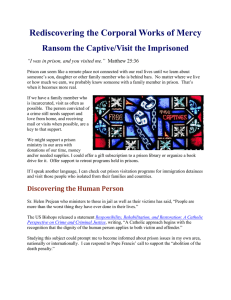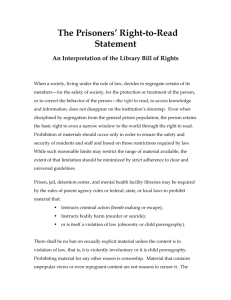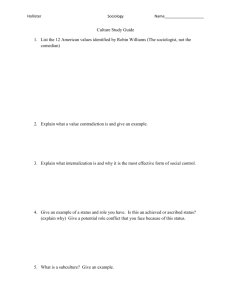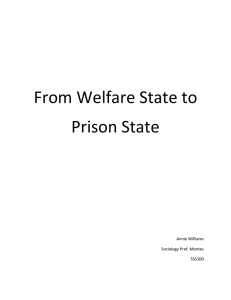PSYSCHO ‐SOCIAL PR ROFILE OF
advertisement
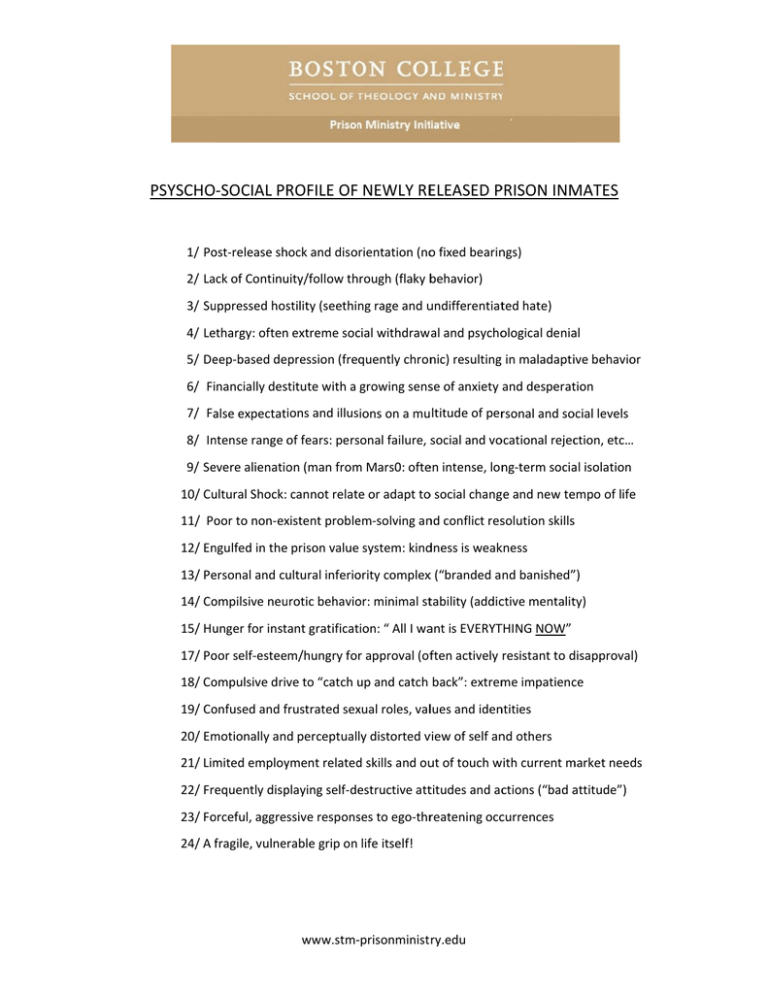
PSYSCHO‐SOCIAL PR ROFILE OF NEWLY REELEASED PPRISON INM MATES 1/ Po ost‐release sh hock and disorientation (noo fixed bearin ngs) 2/ Lack of Continu uity/follow through (flaky bbehavior) 3/ Su uppressed hosstility (seethin ng rage and uundifferentiatted hate) 4/ Lethargy: often n extreme soccial withdraw al and psycho ological deniaal 5/ Deep‐based de e pression (freq quently chronnic) resulting in maladaptiive behavior 6/ Financially desstitute with a growing sensse of anxiety and desperattion 7/ Faalse expectations and illusions on a mu ltitude of perrsonal and so ocial levels 8/ In ntense range o of fears: perssonal failure, ssocial and vo ocational rejecction, etc… 9/ Severe alienatio e on (man from m Mars0: ofteen intense, lon ng‐term sociaal isolation 10/ Cu ultural Shock: cannot relate or adapt too social change and new teempo of life 11/ Po oor to non‐exxistent proble em‐solving annd conflict ressolution skillss 12/ En ngulfed in the e prison value system: kinddness is weakkness 13/ Pe ersonal and cu ultural inferio ority complexx (“branded a nd banished””) 14/ Co ompilsive neu urotic behavio or: minimal sttability (addicctive mentalitty) 15/ Hu unger for instant gratification: “ All I waant is EVERYTTHING NOW” 17/ Po oor self‐esteem/hungry forr approval (offten actively resistant to d disapproval) 18/ Co ompulsive drivve to “catch u up and catch back”: extrem me impatiencce 19/ Co onfused and ffrustrated sexxual roles, vallues and iden ntities 20/ Em motionally and perceptuallly distorted vview of self an nd others 21/ Lim mited employyment related d skills and ouut of touch with current m market needs 22/ Fre equently disp playing self‐de estructive atttitudes and acctions (“bad aattitude”) 23/ Fo orceful, aggressive responsses to ego‐thrreatening occcurrences 24/ A ffragile, vulnerable grip on life itself! www.stm‐‐prisonminist ry.edu PR REDICTABLLE STAGES OF POST_RELEASE A ADAPTATIO ON 1‐2 weeks 1 Multilevel shoock, grief & m mental disarraay! 3‐6 weeks 3 Lost in densee fog: numb, p passive attitude 7‐12 weeks 7 Bouncing off the walls: higgh stress leveel 3‐6 months 3 ustrated Body out, minnd in; very fru 6‐12 months 6 Daily life on aa runaway rolller‐coaster 12‐18 months 1 s Just hanging J on; sick of beeing out of co ontrol 18‐24 months 1 s Building a ho use of cards: a fragile construct 24‐30 months 2 s Finally free, nnow what? W What source of power? 30‐36 months 3 s Hungry for prrogress, but ffearful and un ncertain 36‐42 months 3 s Three year itc T ch: another m major turning point 42‐48 months 4 s Leap of faith… …a fresh com mmitment to tthe future 48‐54 months 4 s Building & fo cusing on thee vision: faith essential 54‐60 months 5 s Steady progre S ess/taking co ontrol: apply d discipline 60 months for 6 rward Begin shift froom mere survvival to qualitty of life. www.stm‐‐prisonminist ry.edu CHILDREN AND D FAMILIESS OF PRISO ONERS: BEST PRACTIICES Sister Suzanne Jabro, C CSJ Founder aand Executive e Director of tthe Center for Restorativee Justice Workks October 2 29, 2010 Introducin ng the topic: Katelynn Daltton and Elke D’Haeyer School of Theology and d Ministry 1. Sttatistics & Challenges US Demograph hics o 1.7 million children had a parentt in prison or jail in 2007, aan 82% increaase since 199 91.1 o 1/43 A American Children o 1/15 Black Children 1/42 Latino o children 1/111 Whitte children2 ½ of th hese children are under 10 0, average agee is estimated d at 8 years o old3 1 Challenges4 Incarcerated Pa arents and Their Children, Trend ds 1991‐2007. Fe ebruary 2009. W Washington, D.C.:: The Sentencingg Project, 2009. p. 2 2 The Sentencingg Project, p. 2 3 Children and Fa amilies of the Inccarcerated Fact SSheet 2009. The e National Resouurce Center of Chhildren and Fam milies of the Incarrcerated, 22009. p. 1 4 La Vigne, Nancyy J., Elisabeth Daavies, and Diana Brazzell. Februaary, 2008. Brokeen Bonds, Undersstanding and Ad ddressing the Neeeds of C Children with Inccarcerated Paren nts. Washington D.C.: Urban Insttitute Justice Poolicy Center. p. 3‐10 www.stm‐‐prisonminist ry.edu o Daily life is affected d: children’s liiving arrange ments, changges in parent‐‐child onships, and cchanges in fin nancial circum mstances. relatio o Emotio onal and behavioral impacct on childrenn affected by incarceration n: Short term emotional im mpact: stress,, sadness, feaar, lower self‐esteem, resulting in chronic ssleeplessness, difficulties cconcentratingg, depression, and anti‐soccial behavior. Long term reactions: reaactive behavi ors, coping patterns, higher risk of men ntal health prob blems, drug u use, below‐avverage academ mic performaance or drop o out of school, une employment aand possible delinquent behavior. Onee (UK) study showed thaat among boyys who experiienced parental incarcerattion before th he 5 age of ten, nearly half w were convictedd of a crime aas adults. 2. Recommendattions In n a recent study done by th he Urban Insttitute Justice Policy Centerr suggests futture work to ffocus on new research, changes in policy, and increased pr ograms “The grow wing number of children w with an incarceerated parentt represents oone of the mo ost significantt collateral consequencees of the recorrd prison pop pulation in thee U.S” ‐The Sentencing Projecct, 2009 Create Policiess which: o 5 Support parent/child relationshiips by providiing programm ming that enccourages good d parentting as well ass bonding witth children.6 554% of motheers and 57% o of fathers in sstate prisons reported ne ever receivingg a visit from their children n.7 La Vigne, Nancyy J., p. 7 6 The Sentencingg Project, p. 10 7 The National Re esource Center o of Children and Families of the Incarcerated, p. 4 www.stm‐‐prisonminist ry.edu o Consid der children’s needs duringg arrest and ssentencing8 o Enhance reentry prrogramming sso to developp a means for incarcerated parents by w which 9 to reunite with their children. o Revise e ineffective le egislation thaat focuses on a retributive system ratheer than rehabiilitation and rreconciliation n within the w whole commu unity. “We inten nded these ch hildren. It neveer seriously o occurred to mee that if my cchildren had a a living parent, that perso on shouldn’t b be fully know wn to them.” ‐Elizabeth h Gaynes10 more program ms Need for m o Th here are programs but theyy are often lim mited by bud dgets. We neeed programs tthat focus on strenggthening pare ent‐children rrelationships, supporting ccaregivers, fam mily embers, and communitiess that are affeected by pareental incarceraation. me o So ome successfu ul programs: Abraham House e, Bronx, NY (w www.abrahamhouse.org) Gett on the Bus, Los Angeles, CA (www.gettonthebus.uss) Hour Children, LLong Island Ciity, NY (www w.hourchildren n.org) e Osborne Association, Quueens, NY (ww ww.osbornen ny.org) The Reaad To Me Mo ommy, Framinngham, MA (initiated by Siister Maureen Clark, CSJ) “Children with parentss in prison neeed support an nd there are vvery few programs and soccial services specificallly designed to o serve their ccomplicated a and layered nneeds.”11 8 ‐ Urban Institutee Justice Policcy Center, 2008 Bernstein, Nell.. All alone in the world: Children of the incarcera ated. New York: New Press: Disttributed by W.W W. Norton, 2005. pp. 257‐ 2270. 9 The Sentencingg Project, p. 10 10 Bernstein, p. 9 94 11 La Vigne, Nanccy J., p. 13 www.stm‐‐prisonminist ry.edu Biblio ography Incarcerated Parents a and Their Child dren, Trends 1991‐2007. FFebruary 20099. Washington, D.C.: The Sentencin ng Project. http://ww ww.sentencingproject.org//doc/publicattions/publicattions/inc_incarceratedparrents.pdf. Children a and Families o of the Incarceerated Fact Sh heet 2009. Thhe National Reesource Centter of Children n and Families o of the Incarce erated. http:///fcnetwork.org/wp/wp‐coontent/upload ds/fact‐sheett.pdf. One in 100: Behind Barrs in America.. 2008. Washington, DC: PPEW Center on the States. http://ww ww.pewtrustss.org/uploade edFiles/wwwp pewtrustsorgg/Reports/sen ntencing_and d_correctionss/one _in_100.p pdf. Bernstein, Nell. All alon ne in the Worrld: Children o of the Incarceerated. New YYork: New Preess: Distributeed by W.W. Norrton, 2005. Golden, R Renny. War on n the Family: Mothers in P Prison and thee Families Theey Leave Behiind. New Yorkk: Routledge e, 2005. Kinsella, B Bridget. Visitin ng Life: Wom men Doing Tim me on the Outtside. New Yo ork: Harmony Books, 2007.. La Vigne, Nancy J., Elisabeth Davies, and Diana B Brazzell. Februuary, 2008. Broken Bonds, Understandiing and Addreessing the Neeeds of Childreen with Incarccerated Parennts. Washingtton D.C.: Urb ban Institute Justice Po olicy Center. h http://www.u urban.org/UploadedPDF/4411616_incarccerated_pareents.pdf. Martone, Cynthia. Loviing through B Bars: Children n with Parentss in Prison. Saanta Monica, CA: Santa Mo onica 05. Press, 200 www.stm‐‐prisonminist ry.edu CARE FOR R THE CAREEGIVERS TTALKING PO OINTS. es Swearingen, M.D. Dr. Charle Here follow some ideas relevant to C Caring for the C Caregivers: A. Careggivers often negglect themselvves, for variouss reasons. Typiical reasons include the belieef that they aree invulnerable or that on nly the needs o of the other tru uly matter. Sannctity versus prride, foolhardiness. B. The co oncept of "Stre ess" has becom me so vast and broad that im precision is rifee in its usage, and its vaguen ness often leaads to lack of sspecifics in rem medying it. peak of "stressors" those eve ents, situationss, or IDEAS ABO OUT THEM, wh hich lead to C. Stresss: 1. We can sp dysphoric and/or disab bling psycho‐ph hysiological staates. e are generally acknowledged d stressors. The e Holmes‐Rahee list (death of f a spouse, etc)). Yet, each D. There person h has his/her own "list", own "b buttons" which h set off the st ress response perceived/expe erienced. This leads to a speccific psychophyysiological statte E Stress is a response tto something p n general, is co omprised of adrenergic dominance, the FIG GHT OR FLIGHTT state. which, in nse is nature's w way of prepariing the organissm for defensee; originally, on ne F. The Fight or Flight sstate or respon or fled the sabrretooth tiger. fought o undational statte of stress, the e heart may sppeed, gut consttrict, eyes focu us, muscles ten nse. G. In thiss state, the fou If only time limited, it iis acute stress,, which may orr may not be haarmful H. But if the stressors p persist, chronicc stress may en nsue. This is al ways harmful. The external sstressors then e internal mem mories of the stressors may innduce the statee (PTSD is the p prime examplee) may not abate, OR the onic stress, the e "symptom listt" broadens. It may include hheadaches, GI ttroubles, back pain, cardiac I. In chro arrythmias, constant anxiety, depresssion. UT. " Burnout" is the end statte, seen when caregivers collapse, in which h chronic J. And, fiinally, BURNOU unalleviaated stress hass supervened aand the person n can, to a greaat degree, no lo onger function n. K. People with high ide eals who are ve ery demandingg of themselve s, unforgiving, are at risk for chronic stresss and burn nout. www.stm‐‐prisonminist ry.edu L. In add dition, numerous studies have e shown a tigh ht correlation bbetween chron nic unrelieved sstress and card diac disease. (The correlatio on with cancerr is much less e evidence basedd.) opt for relief. Th his may prove M. Any rremedy beginss "within" ; i.e.,, the individuall has to make aa decision to o hard for some people w whose conscie ences are extre emely unforgiv ing and who w will define relief as failure. n of God and haave needs and N. Careggivers are not aa special species. Like all creaation, they, wee, are children vulnerab bilities which m must be attended to. It may take courage too admit one's llimitations. by burnout is n not a virtuous aact. Any contro oversy about that? O. Ethicaal Principle?: ccareer suicide b es of remedies for stress and for the prevenntion/treatment of burnout. 1. Alloplastic: we P. There are two classe ent, the stressful circumstancces and 2. Autooplastic: We op perate in somee fashion upon change tthe environme ourselve es while remain ning in the sam me circumstances. These twoo are not diametrically oppossed; there are nuances will be incurred d and advice/suupport/permisssion may be reequired from Q. For allloplastic changge, tradeoffs w others. EE.g., if one cutss back the hours of one's min nistry, all of theese will pertain n, and a period d of readjustmeent must be negotiated. dies we do som mething with/for our minds, bodies, spirits.. The data on eexercise is firm m R. In auttoplastic remed and posiitive. Prayer may help, but, o of course, careggivers who aree religious or m ministers may aalready have tested th he limits of praayer without co oncrete, speciffic relief. Med itation/Centerring prayer is a very powerful tool. It in nduces the Relaxation Respo onse, which is tthe diametricall opposite of th he Fight/Flightt response. Weell studied by Benson et aal. Finding tthe "still point in the moving world" is a goal of all forms of meditation.. portant to disceern who is who o S. Other people may be hell (stressorrs) or heaven (suppliers of reelief). Very imp eally empathic support, tailorred to an indiv idual's specificc plight, can bee a great relief and whicch is which. Re from stress. hear much about 'support gro oups". But grou ups have very powerful dynaamics and shou uld eschew So, we h narrative es and dialogs which can vee er towards makking people feeel even worse. (Yes, this happ pens) psychotropic m medication mayy be of help in some instancees. Caregivers need to know the T. Psychotherapy and p ms of anxiety aand depression n and how the may show up in themselves. symptom U. Botto om Line: caring for caregivers, ourselves inccluded, is no siggn of failure. In n fact, like gettting an oil chan nge for the aauto, it is prude ent, and is an investment in tthe possibility of long term survival in the ccaregiving role. www.stm‐‐prisonminist ry.edu SUGGESTTED RESOU URCES Articles: David C. D Duncombe, (l9 992), “The Taask of Prison C Chaplaincy: a n Inmate’s Viiew”, The Jou urnal of Pasto oral Care,46 (2 2). Green M., (2001), “Passtoral counseling in prison: how to be”,, Journal of Paastoral Care, 55(2). James Kee enan, SJ, “The e Sin of Not B Bothering to LLove”, Churchh (Winter 19995). Jeannine D. Romeril an nd Roy M. Tribe, “Prison Pastoral Care: How Chaplaiins See Their Role,” Journa al of Care, 49 (4). Pastoral C Kunen, James S. "Teaching Prisonerrs a Lesson," TThe New Yorkker, July 19955 McIntosh, P., (1988), ""White Privile ege and Male Privilege: A PPersonal Acco ount of Comingg To See Correspondencess through Work in Womenn's Studies", (W Wellesley: Wellesleyy College Centter for Researrch on Wome en) Skotnicki, A., (2004), "TThe Prison Ch haplain and th he Mission off the Church,"" New Theolo ogy Review, 17 7(2). ________ __ (2004) “Fou undations On nce Destroyed d: The Cathol ic Church and d Criminal Jusstice,” Theolo ogical Studies, (6 65). Zimbardo o, P. G. (1971). The power aand pathologgy of imprisonnment. Congrressional Reco ord. Hearings before Subcommittee No. 3 of the C Committee on the Judiciarry, House of R Representativves, 92nd n on Correctio ons, Part II, Prrisons, Prison Reform, and d Prisoners’ Riights: Californ nia. Congress,, First Session (Serial No o. 15) Washinggton, D.C.: U..S. Governme ent Printing O Office. Books: Austin, W W. G., & Worch hel, S., eds., (1979), The So ocial Psycholoogy of Intergrroup Relationss (Monterey: Brooks/Co ole.) Beckner, W W. T., & Park, J., eds., (l998), Correction nal Ministry aand Chaplainccy in Effectivee Jail and Priso on st Ministry ffor the 21 Ceentury (Charlo otte: COPE.) Boyle, G., (2010), Tatto oos on the He eart (New Yorrk: Simon & SSchuster.) www.stm‐‐prisonminist ry.edu Cullen, F.. T., &Agnew, R., (2010), C Criminologicall Theory: Pastt to Present. EEssential Read dings. (NY: Oxxford U.P.) Ciarrocchi, J. W., (1993 3), A Minister’s Handbook of Mental Dissorders, (Mah hwah: Paulistt Press) Covert, H. G., (1995), M Ministry to the Incarcerateed (Chicago: LLoyola Press.) Postmes, T., & Jetten, JJ., eds., (2006 6), Individualiity and the Grroup: Advancces in Social Id dentity (Londo on, England: SSage.) Skotnicki, A., (2008), C Criminal Justicce and the Cattholic Church (Lanham: Sh heed & Ward)) ________ ____, (2000), Religion and d the Developm ment of the A American Pennal System (Laanham : U. P. of America) on Ministry: U Understandin ng Prison Cult ure Inside and Out (Nashvville: B&H Spitale, L., (2002), Priso Publishingg Group.) Tonry, M., (1995), Mallign Neglect: R Race, Crime a and Punishmeent in Americaa (Oxford: Oxxford U.P.) Web Publlications: Coming Home Directorry:www.comiinghomedirecctory.org Criminallyy Unjust: Whyy America's prison policy n needs repair; from Americaa Magazine: http://ww ww.americam magazine.org/content/articcle.cfm?articl e_id=12311 Musen, K., & Zimbardo o, P. G. (1991). “Quiet Rage e: The Stanfoord Prison Exp periment.” (D Documentary)). Stanford, CA: Stanford University. V Video or DVD can be orderred online: http://ww ww.prisonexp p.org/pdf/orderform.pdf US Conferrence of Cath holic Bishops, 2000 Statem ment on CJ: Reesponsibility, Rehabililtatio on and Restoratio on: A Catholicc Perspective on Crime and d Criminal Jusstice, (Nov 155, 2000) www.nccb buscc.org/sdw wp/criminal.sshtml Williams, G., Spiritual EExercises with h Prisoners – 18th Annotattion Retreat Williams, G., Theology of Prison Min nistry http://ww ww.jpminc.org g www.stm‐‐prisonminist ry.edu Web Links Abraham House: www w.abrahamhouse.org American n Rehabilitatio on Ministriess www.arm..org Bethany H House Ministtries www.bethanyhousem ministry.com Center for Restorative e Justice Works www.crjw.org Communiity Resourcess and Justice:: www.crjustice.org Death Pen nalty: www.cclarkprosecutor.org Exodus Trransitional Co ommunity ww ww.etcny.orgg Jesuit Resstorative Justtice Initiative: www.jrji.orgg Jesuit Prisson Ministry,, Inc.: www.jp pminc.org www.jesuits.o w rg Concord Prison n Outreach: w www.concord dprisonoutre ach.org/ ww.partakers..org/ Paartakers: ww Human Kindne ess Foundatio on: www.hum mankindness. org/ Murder Victim M ms Families forr Reconciliation: www.mvvfr.org/ Amnesty International: ww ww.amnesty.o org/ es : Prison Chaplaincy Resource mass readings and prayers:: www.magn nificat.com Magnificat: daily m o prison chap plains: Living Faith Foundaation: daily Caatholic devottionals, free to http:///www.livingfaaith.com/foundation.php o www.ttaize.fr o http:///onlineministtries.creighton.edu/Collab orativeMinisttry/online.htm ml o http:///slu.edu/prayyerbook/ usetts Departtment of Corrrections: Massachu http://ww ww.mass.gov//?pageID=eop psagencyland ding&L=3&L0==Home&L1=PPublic+Safetyy+Agencies&LL2=M assachuse etts+Departm ment+of+Corre ection&sid=EEeops o o Outreach Ministry: ww ww.prisonouttreachministrry.org Union of Correction Officers: www.mcofu.org/ Vera Instiitute of Prison Justice: ww ww.vera.org www.stm‐‐prisonminist ry.edu
